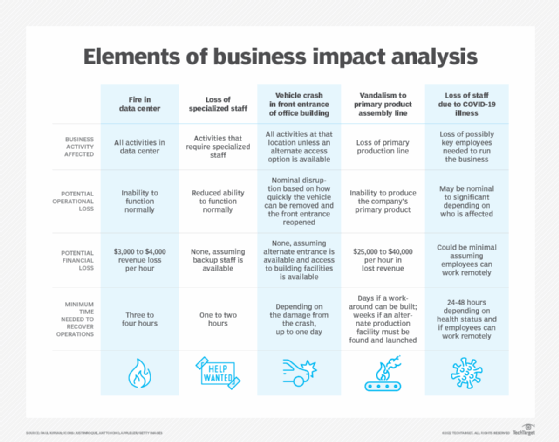
Rawpixel.com - stock.adobe.com
Use a business impact analysis questionnaire to get critical data
The quality of the business impact analysis questionnaire will determine how well prepared your organization is for a disaster. Get started with some tips and sample questions.
A business impact analysis is a key component of business continuity, operational resilience and disaster recovery plans. To get the most out of a BIA, it's critical to ask the right questions.
The business impact analysis process helps organizations identify key business functions and determine the potential effects of a disruptive event on those functions. To gather information for a BIA, organizations typically send questionnaires to departments throughout the business. Once the information has been collected, it can be used to shape business continuity and disaster recovery plans.
A BIA can determine the effects of a crisis on an organization's reputation, financial position, competitive posture, employees, supply chains and other business components. The business impact analysis questionnaire must be a thorough examination of an organization's unique processes to mitigate the most pressing effects of a disruption.
This article discusses the importance of a BIA and provides guidance for shaping a business impact analysis questionnaire. Don't forget to download the included sample questions to create your own employee survey.
Why are BIAs important?
Business impact analyses present a clear picture of the material effects of disruption on a company, in terms of both the potential problems and the likely costs.
A BIA questionnaire can help an organization identify the following:
- Mission-critical processes that must not be interrupted.
- Systems and networks that support those processes.
- Recovery metrics, such as recovery point objective and recovery time objective.
Organizations can use this information to determine the priority of recovery for each mission-critical process and the associated systems and to identify any interdependencies among business units.
Using BIA questionnaires to gather data
Business impact analysis questionnaires help discover potential vulnerabilities and areas of concern by providing different departments with a uniform set of questions about business functions they perform or oversee.
Candidates for questionnaires should include key members of each business unit. Organizations can modify questionnaires for specific departments to address unique attributes, such as a trading department or an HR department.
The individuals or teams in charge of the BIA process then enter the responses to the business impact analysis questionnaire into a suitable repository for analysis, such as a spreadsheet.
The table below presents the kinds of information that might be obtained during a BIA. Prior to the BIA, the organization should conduct a risk assessment. That will enable the organization to identify specific threats or vulnerabilities that it faces. Data captured from the BIA questionnaire will then help identify the affected business functions, potential operational and financial losses, and the minimum time needed to recover operations.

Key BIA questionnaire topics
The initial step in preparing a business impact analysis questionnaire is to define the topic areas for developing questions.
IT is a key component of BIAs since it must be integrated into the organization's overall strategic direction. In a BIA, members of the IT department should be interviewed to learn how they intend to respond to specific situations affecting mission-critical business units.
BIA questionnaires should address the following topics:
- Understanding how each business unit operates.
- Identification of critical business unit processes that depend on IT.
- Identification of required IT resources.
- Financial value of critical business processes.
- Dependencies on internal departments and business units.
- Dependencies on external organizations.
- Minimum time needed to recover mission-critical data to the previous state of use and availability.
- Minimum technology and system requirements needed to conduct mission-critical business processes.
- Minimum time needed to return to normal or near-normal operations following an incident.
- Maximum amount of time the company can tolerate a mission-critical function disruption before its performance and reputation are damaged.
- Minimum number of staff required to conduct business following a disruption.
- Minimum office space required to conduct business following a disruption.
- Minimum office supplies and services needed to conduct business following a disruption.
To help shape your own business impact analysis questionnaire, download this free list of sample questions.
Paul Kirvan, FBCI, CISA, is an independent consultant and technical writer with more than 35 years of experience in business continuity, disaster recovery, resilience, cybersecurity, GRC, telecom and technical writing.









